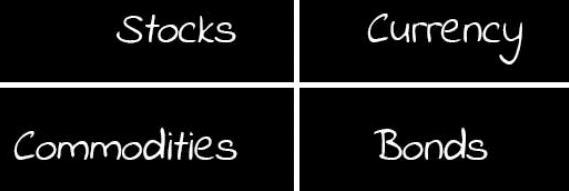The forex market is arguably the most traded market in the word, but that doesn’t make it the end all and be all of all financial markets. The forex market is also affected to some degree by various other markets. Every financial market functions according to its own internal dynamics which are based on its sentiment, positioning, news, and data. A strong understanding of how different markets are related can help you be ahead of the curve when it comes to forex trading.

Currently, there is a myriad of algorithms that trade forex related markets in real-time. There are a bunch of new fintech start-ups that let people know what is driving currency markets at the moment. However, even with all the competition, looking at Intermarket relationships between forex and other markets is a great source of understanding and edge for discretionary manual currency traders. With that being said, let’s take a look at the relationships between the forex market and other financial markets.
Relationship with Gold
There are three main uses for gold: serving as a store of value in times of economic downturn, a hedge against inflation, and as an alternative to the U.S dollar. The relationship is more inverse in the long-term, with a higher gold price usually occurring after the USD weakens and vice versa. The relationship in the short-term is tenuous. Usually, the gold trader is more interested in what the dollar does, more than the other way around. This is because the gold market is significantly smaller than the forex market. However, extreme movements in gold prices attract the attention of forex traders and influence the dollar in an inverse way.
Relationship with Equity Index
Ever since the U.S. economy started to recover and outperform its peers around 2012, stronger US equities were a sign of US strength. This meant that after this period, rallies in equities translated to a stronger dollar. It’s thus crucial to be aware of what regime a trader is in when analysing any correlations between equity indices and currencies. There is some correlation between these two instruments but the relationships are mostly unstable. As a trader, you should thus look out for changes in magnitude or direction of correlation.
A good example of a reliable equity index and forex relationship would be the Nikkei vs USD/JPY. This is due to Japanese citizens holding the largest pool of savings in the world. When the economy and market is in good shape, they usually buy foreign assets and sell JPY for higher returns. The inverse happens when there is a dip in the market. This directly affects the USD/JPY currency pair. Another example of a good relationship between these two markets is the AUD/CAD vs the ratio of Australian to Canadian Equities.
Relationship with the Stock Market
Stocks are microeconomic securities that rise and fall in response to individual corporate results and prospects. Currencies on the other hand are essentially macroeconomic securities. They fluctuate in response to wider changing economic and political factors. Thus, at a glance, the two markets do not have anything and common and thus, the relationship shouldn’t matter. However, these two markets occasionally intersect. This happens usually for very short periods, only at the extremes. For instance, volatility in this market crosses extraordinary levels, the USD can experience more pressure than it otherwise would. However, these relationships aren’t really reliable all the time.
Relationship with Exchange Traded Funds
As a trader, you can take a look at individual ETFs that relate to the current currency pair you are trading. For instance, in the case of Australia, you might want to watch the China AShares ETF(FXI) and BHP or Freeport (mining stocks). If you use ETFs, it helps you focus on what’s happening in individual sectors that are relevant to the currency you are trading. Particularly powerful use of ETFs is for searching divergence or confirmation. For instance, if you see a big divergence between copper and AUD, the first thing you should do is check out the trading levels of both Freeport and BHP. The mining stocks could simply confirm the copper move which would give a stronger signal for the AUD.
Relationship with Oil
There is a lot of misconceptions regarding the relationship between oil and certain currencies such as the USD, CAD, and JPY. The idea is that the currencies of oil-producing countries are positively or negatively affected by increases or decreases in the price of oil. Thus the theory is that if a country is an importer of oil, its currencies will be hurt if there are higher oil prices and vice versa. However, countless relationship studies have shown that this relationship is not reliable, especially in the short-run.
Thus, the best way to look at this relationship is to look at oil as an inflation input and thus, as a limiting factor on overall economic growth. This means that the higher the price of oil, the higher the inflation level which means the growth of the economy is slower. However, always remember that oil is just one input among many.
Relationship with Bonds
When it comes to fixed income and bond markets, they have a more intuitive connection with the forex market because of being influenced by interest rate expansions. In the short-term, however, a viable link between the two markets cannot be established as all attempts are interrupted by the short-term market dynamics of supply and demand. Depending on shifts in interest rate expectations, the forex market reacts first and fastest. At other times, changes in interest rate expectations are accurately reflected by the bond market, with the forex market later doing the same.
As a forex trader, you should definitely keep an eye on the yields of the benchmark government bonds of the major currency countries. This allows you to better monitor the expectations of the interest rate market. Any change in interest rate differentials can exert a major change in the forex market.
Final Thoughts
The forex market functions with its own sets of rules and conventions. To be a better trader, you should know how to analyze the movements other markets are experiencing and take decisions if they affect the currency market.








Leave a Reply